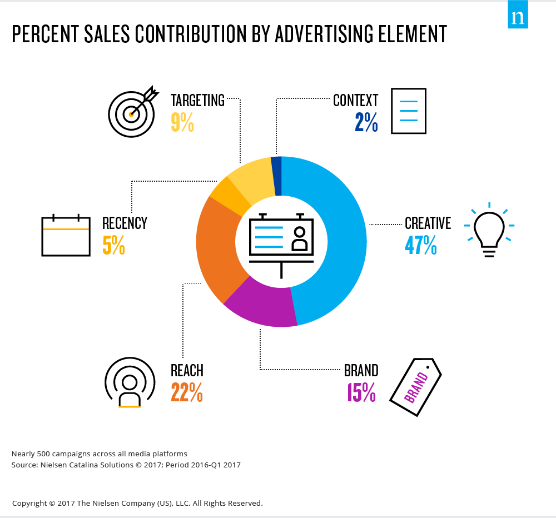The first TV commercial ever aired was a $9 spot for Bulova Watch Co. in 1941 that featured the simple tagline “America runs on Bulova time”. In the last 75+ years, the advertising industry has grown into an industry that generates billions of dollars a year (Source: QZ.com, 2016). The creative itself has also evolved with iconic campaigns like Budweiser’s “Wassup”, Old Spice’s “The Man your Man Could Smell Like”, and Snickers’ “You’re Not You When You’re Hungry” that became etched into consumers’ memory and were often discussed in popular culture. However, these campaigns are the industry exception versus the rule. The fact is that making attention grabbing, effective creative is hard but it is crucially important. According to Nielsen, creative represents 47% of a campaign’s effectiveness (Source: Nielsen, Five Keys to Advertising Effectiveness, August 2017).

The media landscape is complex with more platforms, ad formats, and technology available than ever before. While this provides great opportunity to push creative boundaries, it is easy for marketers to become enamored by all the different tools that are available for targeting, dynamic messaging, data integrations, and creative versioning and fall into an “I want it all” mentality without understanding how each piece fits into their strategy. This is a sure-fire way for the creative process to crumble and the marketer to end up with creative that does not hit upon stated brand KPIs. We are happy that IAB has crafted the Kickstarting Creative Success guide based on input from its members which can serve as both a checklist and a best practice guide for marketers to enable more effective creative.
Being creative leaders at our respective companies of BBDO, Sibling Rivalry, and Teads, there are a couple of common stumbling blocks that we encounter throughout the creative campaign process:
- Lack of a clearly defined campaign objective (i.e. store traffic, app downloads, brand awareness, etc.). Each campaign objective will open up a different conversation on strategy which then dovetails into creative. It is crucially important that every party involved in the campaign (including both the media and creative stakeholders!) understand the marketer objective and drive towards that specific goal.
- The RFP is not specific and does not include details surrounding the creative assets, primary messaging, and consumer product benefits. If the RFP simply states that the marketer wants a 30 second video asset, that leaves a lot of unanswered questions. Should there be a specific call-to-action or is there a consumer benefit that must be communicated? What platforms is this asset going to appear in (mobile, OTT)? To avoid a scenario where the creative team creates an engaging ad that cannot be properly executed because the media plan is limiting the output, the marketer should integrate the creative brief within the media brief. This enables everyone to be on the same page in terms of what the creative assets need to accomplish for the brand story.
- Lack of media strategy and understanding of platform specificity: Beyond having an RFP and an understanding of asset type, there needs to be a clear media strategy and an understanding of what purpose each platform is serving. Why do consumers spend time on Facebook, Instagram, and other platforms? How does storytelling work on each of those platforms, what is the user engagement model, and how should advertising function as a result? Sometimes the marketer’s partners get that information but hearing it directly from the client would be helpful.
- Marketers are not comfortable adopting a “test and learn” mentality: The initial media plan is not set in stone. Marketers should feel empowered to analyze what is performing well and adjust accordingly. Teads practices “evidence based creative” and this idea is built on the foundational understanding that every campaign is an opportunity to test and learn. It can be as simple as an A/B test on two different layouts for a creative or it can be as complex as long-term multivariate testing across hundreds of creative versions. The point is every marketer can do it.
The Kickstarting Creative Success guide outlines these tips and more and can be used as a beginning point to ensure that marketers are starting out on the right foot with their creative planning process.
Once these key considerations are taken into account, that’s when the industry can really start to push the creative envelope. For example, the industry has made progress on newer video formats like vertical video. Six months ago, we were still talking about the issues with vertical video and how to create guidelines and best practices for the format. Now, we are having meetings where it is quickly agreed upon that we are shooting vertical first video with a premium director. What are the next steps to continue to push the boundary with a format like vertical video? How can we understand whether tactics like aligning frames horizontally (left to right) perform better in a mobile environment compared to aligning frames vertically (one on top of the other)? These are more sophisticated hypotheses that we should be spending our time testing and where we can spend our time once the basic creative campaign guidelines are checked off.
With open-mindedness and collaboration, creativity will continue to flourish and who knows what the future of advertising holds. Ten years from now we could be talking about holographic advertisements that appear in the back seat of self-driving cars. The sky’s the limit!
As the year continues, we look forward to continuing to work with IAB to foster relationships across the digital landscape and partner on a few specific initiatives to drive the creative conversation forward like a better understanding how science and art work together with data-driven video and how the industry can better measure “did it work.”




